UK Consumer Price Inflation (CPI) fell from October’s 41-year high to 10.7% over the 12 months to November, according to the latest set of data from the Office for National Statistics (ONS).
The largest downward contributors to the drop in inflation came from transport, particularly motor fuels, which was partially offset by rising prices in restaurants, cafes and pubs.
The fall was larger than expected after the Bank of England had forecast a 10.9% figure for November.
Beginning of the end for the inflationary bubble?
The main debate among industry commentators is now whether October’s 11.1% figure was the ceiling, following a year in which inflation has climbed to levels last seen in the 1980s.
James Lynch, Aegon Asset Management fixed income investment manager, said: “[The CPI drop] most likely confirms that October 2022 was the peak in inflation. We would expect inflation in the UK to continue to trend lower in 2023 as demand in the economy falls, the supply chain difficulties post-Covid are fading away, and the energy prices will not be rising at the same rate of change as they did in 2022.”
Wealth Club investment analyst Nicholas Hyett warned that while the headline rate of inflation has decreased, price increases in a range of sectors suggests that core inflation will continue to be a concern.
He said: “[Latest CPI data] raises some difficult questions for policy makers. On the one hand headline inflation is easing, but whether that’s due to a weakening in local demand or simply global commodity prices is less clear. Areas like hospitality, which are more affected by domestic inflation, continue to see prices rise substantially, suggesting ‘core inflation’ remains untamed. That’s a headache for central bankers – raising rates might help bring domestic inflation under control, but it will also exacerbate the cost of living crisis and potentially condemn the UK to a painful recession.
“Today’s inflation numbers really raise more questions than answers. Is this just a blip in an ongoing inflationary trend or the beginning of the end of the inflationary bubble? We will have to wait for more data to be sure. The BoE Monetary Policy Committee doesn’t have that luxury though – tomorrow’s interest rate decision will tell us a lot about where they think the economy is heading.”
Inflation to decelerate in 2023
While questions remain over whether inflation has peaked in the UK, there is consensus that it will decelerate in 2023, with commentators now looking for how November’s CPI data will feed into the BoE’s decision making on interest rate increases.
Derrick Dunne, chief executive of You Asset Management, said: “The BoE has forecasted that CPI inflation will start to fall slowly from early next year, so today’s data could well be a sign of inflation beginning to roll over. That said, the bank also predicts it will take around two more years to reach its target level of 2%. This means it could be some time until the pressure truly starts to ease for UK households, particularly with yesterday’s labour market figures showing a significant fall in real pay growth.
“For investors, while no one can really call where inflation and markets will go from here, they can take comfort in the fact there will always be good opportunities available, especially for those that use carefully planned wealth management to achieve their long-term goals.”
Daniel Casali, chief investment strategist at Evelyn Partners, said: “Though CPI inflation slowed in November from October, the data has yet to show conclusive evidence that it has indeed peaked. For instance, there remains upward inflation pressure in services: the annual rate for restaurants and hotels was 10.2% in November 2022, up from 9.6% in October and the highest rate since December 1991.”
He added: “Nevertheless, CPI inflation should decelerate in 2023, as expected by the consensus of economists. First, slowing economic growth, along with higher taxes, rising mortgage rates and less government support on energy prices next year is likely to be a drag on real household take-home pay in 2023. Lower discretionary incomes should prove to be significant headwind against accelerating inflation from here.
“Second, core output Producer Price Inflation has deteriorated to 13.2% in October, after peaking in the summer at 14.9%. Over time, the lower cost of inputs into production should exert downward pressure on consumer prices. Third, high base effects from sharp price increases in 2022 will make it difficult to sustain high annual CPI inflation rates in 2023. And fourth, the impact of supply chains disruption on creating inflation in the goods market from the pandemic should begin to fade.”











